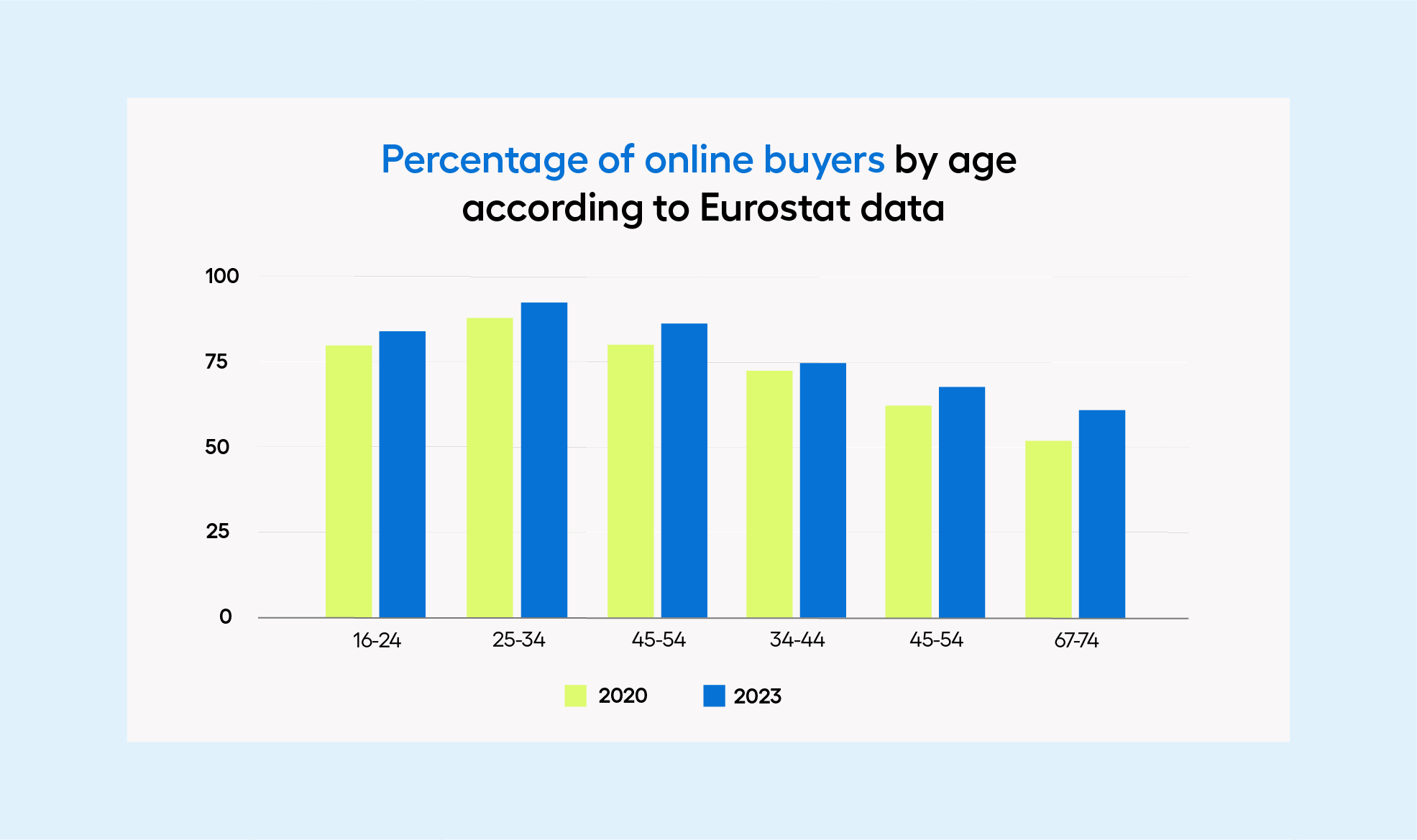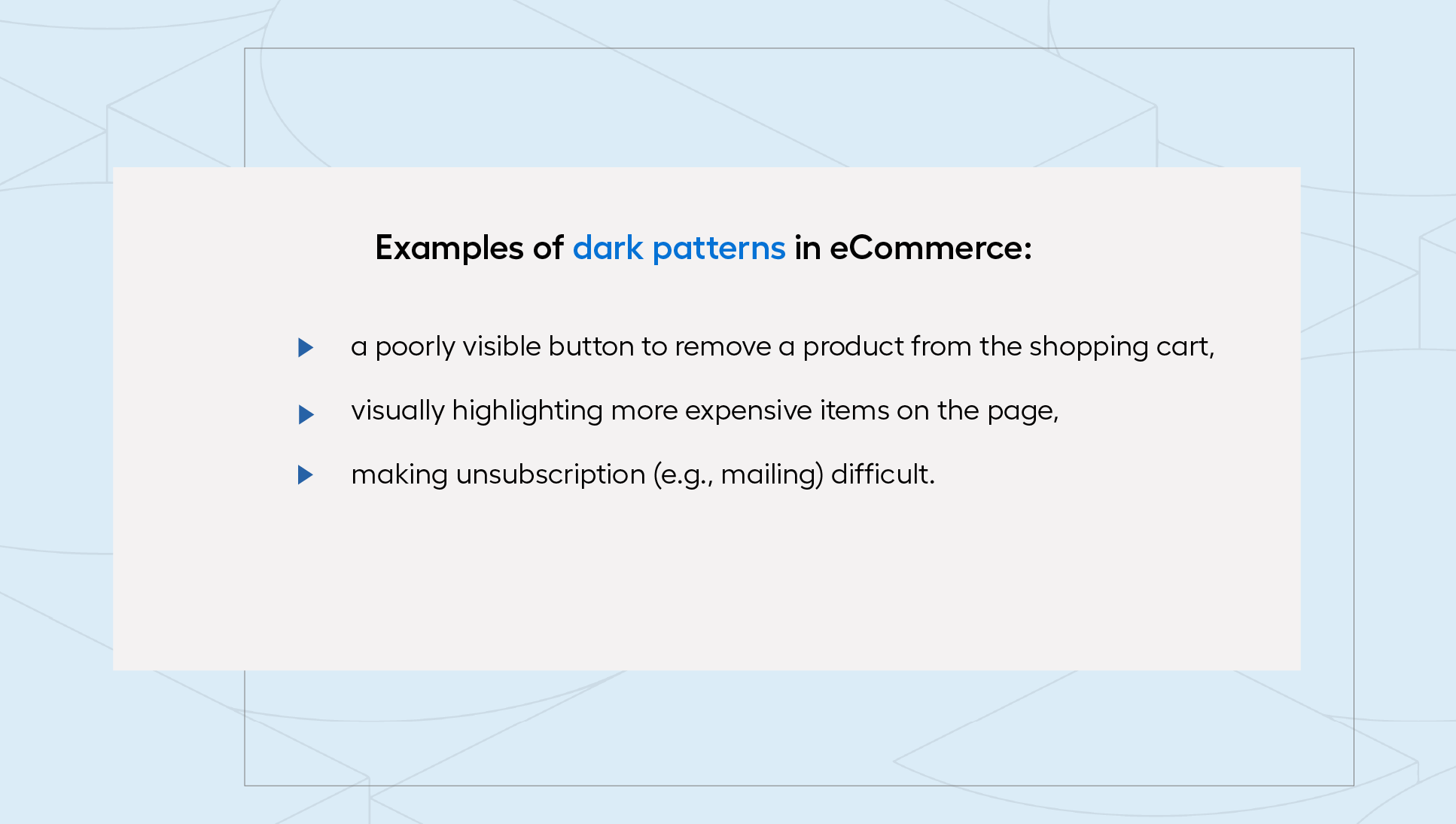Table of contents
- The ups and downs of Artificial Intelligence in eCommerce
- Multiple generations shopping online, meaning higher expectations for e-stores
- Personalization vs Privacy
- Increasing number of sales channels = increasing amount of customer data
- New regulations - DSA and eCommerce
- eCommerce in 2024 - what’s next?
The beginning of the year is always a time filled with excitement about new trends and industry forecasts. The end of the year, on the other hand, is associated with summaries and evaluations of past events. What happens in between? The eCommerce industry is dynamically changing month by month, and the mid-year point is the perfect time to review achievements so far, identify challenges, and understand upcoming opportunities.
In this article, we will examine the key issues defining eCommerce in the second half of 2024. You will read about how the increasing online presence of the Silvers generation (people over 50 years old) expands the group of buyers. You will also learn about new legal changes (especially in polish and UE law), controversies surrounding artificial intelligence, and advancements in customer experience personalization.
Are you curious about the factors shaping the future of eCommerce? You will discover the most interesting ones in this article!
The ups and downs of Artificial Intelligence in eCommerce
It's hard to count how many times the term "artificial intelligence" (AI) has come up in the context of eCommerce development in 2024. There has long been a boom in AI-powered tools—companies are competing to provide solutions for automatic content generation, graphic creation, rapid analysis of large data sets, and the personalization of shopping experiences. The application of AI opens doors to faster and more precise responses to changing market needs and customer preferences. This allows stores to better segment customers into groups, deliver more relevant offers, and optimise logistical processes and customer service. So, where do the potential difficulties lie among these benefits?
Despite its undeniable potential, AI is still not free from flaws and limitations that require further development and refinement. One of the main problems is the creation of generic content. Ready-made tools often "produce" texts full of repetitive phrases and templated expressions, as well as unrealistic graphics (e.g., characters with twisted hands). Such content not only fails to attract buyers but often requires manual modification, generating additional costs. Moreover, there is also a risk of unforeseen algorithm errors that can lead to undesirable and unprofitable business effects (e.g., recommending products for sale at a knockdown price).
For many, the challenge also lies in the implementation of these tools. While there are AI-powered plugins and modules available on the market with low licensing costs, creating a custom solution or conducting a larger integration is a significant investment. In addition to the costs of the tools themselves, there are also expenses related to adapting IT infrastructure. Therefore, a conscious and responsible approach to AI in business is crucial—the choice of tools should genuinely improve the efficiency of the online store (both now and in the future) and not be driven by a temporary trend following the principle "if everyone has it, I must have it too."
Multiple generations shopping online, meaning higher expectations for e-stores
Online shopping is no longer the domain of the few or just an alternative to traditional stores. Today, virtually all generations use eCommerce platforms. According to Eurostat statistics, over 60% of people over the age of 55 shop online, which represents a significant increase compared to previous years. Moreover, the younger generation, raised in the internet age, is also becoming active consumers. For the eCommerce industry, this presents an opportunity to significantly expand the customer base, but also a new challenge: meeting the diverse needs of all shoppers.

The age difference among consumers entails different shopping requirements. On the one hand, online sales must adapt to the needs of the older generation of shoppers (also known as Silvers) and consider aspects such as:
- Clear UX - ability to zoom text and images, intuitive navigation, simplified forms.
- Safety - dimple payment processes, clear information about products and the store, data protection.
- Customer support - available helpline, email contact options, assistance with placing orders.
- Accessibility - adapting the site for people with various limitations, e.g., integrating screen readers for the visually impaired.
Unified commerce to elastyczna strategia, która może być dostosowana do specyficznych potrzeb każdego sklepu internetowego i w zależności od struktury biznesu - dowolnie rozbudowywana. Dzięki temu możliwe jest skuteczne reagowanie na dynamicznie zmieniające się potrzeby rynku oraz oczekiwania klientów.
On the other hand, the younger generation expects the e-store to offer them:
- Fast shopping process - ability to make payments using popular mobile apps or same-day shipping.
- Personalised experiences - product recommendations tailored to individual needs and preferences.
- Responsible approach to business - ecology, ethics, transparency of company operations.
Provided that the store's offerings are not explicitly aimed at a certain age group - online stores must find the fine balance to meet the expectations of all age groups, a challenge that requires careful planning both in terms of technical preparation of the platform and balanced communication.
Personalization vs Privacy
Nine out of ten customers are willing to share their data in exchange for more personalized offers that match their needs and preferences. This statistic, presented by a BGC study, shows that the need for personalization is a real trend in the industry. However, customers expect authentic actions that go beyond superficial solutions, such as greeting the user by name on the site after logging in or preparing a few versions of mailings. In today's busy world, consumers need real support in the shopping process, for example, through product suggestions that match their interests or automatic indications of the nearest pickup points without the need to choose them manually.
However, the need for personalization does not mean that customers are ready to fully disclose their data. With increasing awareness of online threats, more and more users are paying attention to the protection of their personal data. They expect their privacy to be respected, and sharing information about themselves to be done reasonably and in a controlled manner. Legal regulations (e.g., GDPR) also follow this line of thought, imposing frameworks on data use and collection. For entrepreneurs, this means finding a balance between offering personalised services and ensuring a high level of data protection. This is necessary to gain and maintain customer trust. A key element in achieving this balance is transparency and informing customers about how their data is collected and used, allowing them to comfortably share their information.
Increasing number of sales channels = increasing amount of customer data
An online store should sell multichannel, or omnichannel. This was the case until recently. Nowadays, the expectation is for an experience in line with a unified commerce strategy, which means not only the availability of the brand across multiple channels, but also the intertwining of the shopping experience across all of them. This is one challenge that entails another. With selling in multiple places at once, it also involves generating huge amounts of data that need to be analysed to ensure effective sales.
Data collected from various sales channels, such as websites, mobile apps, social media, marketplaces, and brick-and-mortar stores, grow almost exponentially every day. Real-time analysis of this data is essential to understand customer needs, personalize offers, optimize marketing activities, and ensure a smooth shopping experience. Neglecting this aspect can lead to:
- missed personalization opportunities - incorrectly matching offers to individual customer needs leads to decreased conversion and satisfaction.
- ineffective marketing activities - lack of knowledge about customer behaviour makes precise targeting of ads and marketing campaigns impossible.
- problems with demand forecasting - incorrect predictions can lead to shortages or surpluses of products, causing financial losses.
To prevent these issues, it is worth investing in data analysis tools, especially Big Data technologies. These advanced tools enable the collection, processing, and interpretation of vast amounts of information, allowing for more precise and efficient management of the e-store.
New regulations - DSA and eCommerce
Since 2023, with the entry into force of the EU Omnibus Directive, elements such as informing about the lowest product price 30 days before a promotion or ensuring the authenticity of reviews have become standard features of online stores in eCommerce. In 2024, the eCommerce industry faces a new challenge related to legal regulations, specifically adapting to new legal requirements. This refers to the Digital Services Act (DSA), which introduces additional regulations crucial for maintaining online transparency. What exactly do these regulations entail?
The goal of the Digital Services Act's provisions is to ensure greater safety and transparency online and eliminate disinformation, which increasingly appears in shared content, such as fake news or reviews. These regulations apply to all digital service providers, including online stores that might use so-called dark patterns tactics designed to mislead users and prompt them to take actions they wouldn't otherwise take without manipulation. Examples of dark patterns include designing platforms to encourage the purchase of more expensive items or hiding buttons that allow the removal of products from the cart.

Additionally, the DSA introduces the concept of Very Large Online Platforms (VLOP), which covers very large platforms with at least 45 million users, imposing additional obligations on them. Among the requirements is providing an easy-to-read and multilingual version of the platform. While most of these platforms are media and social networking sites, large online stores such as Zalando, Amazon, and AliExpress are also included.
The new regulations present a challenge but also encourage raising service and transparency standards, ultimately benefiting both entrepreneurs and consumers.
eCommerce in 2024 - what’s next?
Month by month, new challenges emerge in the world of eCommerce that companies of various scales and profiles must face. Due to the diversity of the eCommerce industry, it’s also difficult to pinpoint a definitive list of challenges. For example, for a large platform selling fashion products, keeping up with the competition in terms of innovative solutions, such as virtual fitting rooms or mobile apps, can be challenging. Although large companies have the budgets to implement innovations, they often lack the time for implementation. On the other hand, smaller stores may struggle to fully leverage the potential of personalization, which requires advanced analytical tools.
These and other challenges - legal, technological, or related to changing shopping habits - are an integral part of the dynamically evolving eCommerce sector. Companies must continually adapt and refine their online sales strategies to overcome new challenges. Navigating these with the right strategy can ensure continued growth, maintain competitiveness, and achieve satisfactory business results. Will you face these eCommerce challenges in the second half of 2024?



